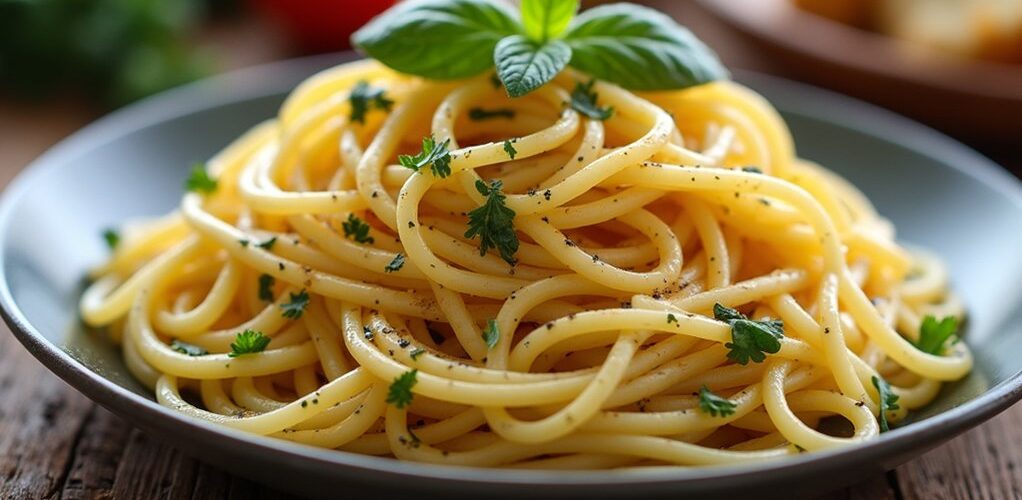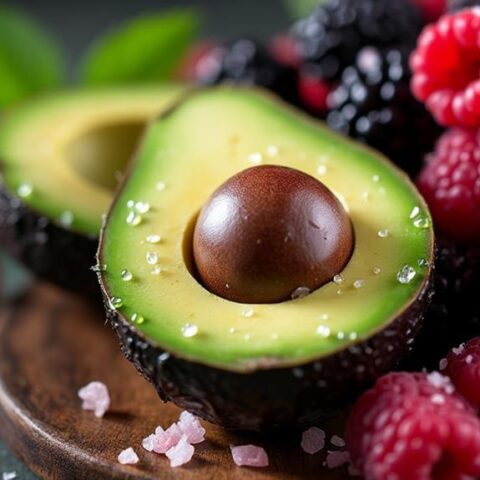
Traditional spaghetti is not low-carb, containing approximately 40 grams of carbohydrates per 100 grams when uncooked. A standard one-cup serving delivers around 43 grams of carbs after cooking, making it challenging for low-carb dieters. While whole grain varieties offer slightly fewer carbs at 30-35 grams per 100 grams, alternatives like zucchini noodles (3g) and spaghetti squash (6.5g) provide considerably lower-carb options. Understanding pasta alternatives opens new possibilities for maintaining a low-carb lifestyle.
Key Takeaways
- Traditional spaghetti is not low-carb, containing approximately 40 grams of carbohydrates per 100 grams in uncooked form.
- A standard one-cup serving of cooked spaghetti contains 43 grams of carbohydrates, making it unsuitable for low-carb diets.
- Whole grain spaghetti offers slightly fewer carbs at 30-35 grams per 100 grams when cooked.
- Low-carb alternatives like zucchini noodles (3g), spaghetti squash (6.5g), and konjac noodles (0g) provide significant carb reductions.
- Traditional pasta's glycemic index ranges from 40-60, though cooking al dente and adding fats can slow carbohydrate absorption.
Understanding Traditional Pasta's Carbohydrate Content
When examining the carbohydrate content of traditional spaghetti, it becomes clear that this beloved pasta dish falls firmly into the high-carbohydrate category.
Traditional pasta contains approximately 40 grams of carbs per 100 grams in its uncooked form, with a standard one-cup serving delivering around 43 grams of carbohydrates after cooking.
A serving of traditional pasta packs over 40 grams of carbohydrates, whether measured dry or after cooking.
While whole grain varieties offer a marginally lower carbohydrate content at 30-35 grams per 100 grams when cooked, they still represent a significant carb intake.
For those seeking low carb pasta alternatives, the contrast is striking when compared to options like zucchini noodles, which contain just 3 grams of carbohydrates per 100 grams.
The refined carbohydrates in traditional pasta can also cause notable blood sugar fluctuations, making it a consideration for those monitoring their carbohydrate intake.
The Science Behind Pasta and Blood Sugar
Traditional pasta's glycemic index varies considerably based on cooking time, with al dente preparation resulting in a slower blood sugar response compared to overcooked pasta.
When consumed, pasta's carbohydrates are broken down into glucose, triggering the pancreas to release insulin for blood sugar regulation, which explains why individuals monitoring their glucose levels should be mindful of portion sizes.
Understanding this metabolic process has led many health-conscious consumers to explore low-carb pasta alternatives, which can help maintain more stable blood sugar levels throughout the day.
The Keto diet is an example of a dietary approach that strictly limits carbohydrate intake to induce ketosis, thereby minimizing blood sugar spikes and potentially benefiting those with insulin sensitivity challenges.
Glycemic Index of Pasta
The science behind pasta's effect on blood sugar reveals a more nuanced picture than many might expect. Regular pasta typically falls within a low to moderate glycemic index range of 40-60, indicating it raises blood sugar levels more gradually than high-GI foods.
The preparation method considerably influences these net carbs, with al dente cooking resulting in a lower glycemic response due to slower digestion.
Whole grain varieties offer even better blood sugar management, with a glycemic index around 37.
However, portion control remains essential, as larger servings can trigger more substantial blood sugar increases.
Adding fiber-rich components like vegetables or legumes to pasta dishes can further moderate the glycemic impact, making traditional pasta a more balanced option when prepared and portioned thoughtfully.
Carb Absorption Rates Explained
Understanding pasta's carbohydrate absorption pattern reveals why blood sugar responses can vary greatly among individuals. The rate at which carbs per serving are absorbed depends on multiple factors, including preparation method and accompanying ingredients. Cooking pasta al dente considerably reduces its glycemic impact compared to softer preparations, while adding pasta sauce rich in fiber and healthy fats can further moderate absorption rates.
| Factor | Impact | Blood Sugar Effect |
|---|---|---|
| Cooking Method | Al dente reduces digestibility | Lower spike |
| Temperature | Cooled pasta resists digestion | Slower absorption |
| Meal Composition | Fats and proteins slow digestion | Gradual release |
| Added Ingredients | Fiber-rich sauces delay absorption | Balanced response |
Managing Blood Sugar Spikes
Monitoring blood sugar response after consuming pasta reveals important insights about its metabolic effects on the body. Traditional pasta's high carbohydrates content can greatly impact blood glucose levels, though its moderate glycemic index suggests a less dramatic spike compared to other refined grains.
To effectively manage blood sugar when consuming pasta:
- Choose whole wheat pasta over refined varieties, as its higher fiber content helps slow carbohydrate absorption.
- Combine pasta with protein sources and healthy fats to reduce the overall glycemic impact.
- Practice portion control to limit total carbohydrate intake per meal.
Understanding these factors allows for more informed pasta consumption, particularly for those monitoring their blood sugar levels.
While pasta remains a high-carb food, strategic meal planning and mindful preparation can help minimize its impact on blood glucose.
Popular Low-Carb Pasta Alternatives
Plant-based alternatives to traditional pasta have revolutionized low-carb eating, with options ranging from versatile vegetable spirals to innovative heart of palm noodles.
Home cooks can create their own keto-friendly pasta using alternatives like almond flour, coconut flour, or even cheese-based doughs that maintain the familiar texture of traditional pasta.
Zero-carb options, such as konjac-based miracle noodles, offer a unique solution for those seeking the lowest possible carbohydrate content while still enjoying pasta-like dishes.
For those interested in high-protein pasta options, edamame and chickpea pastas are excellent choices that provide substantial protein and fiber content while keeping net carbs low.
Plant-Based Noodle Options
For those seeking to reduce their carbohydrate intake while still enjoying pasta-like dishes, several plant-based alternatives offer considerably lower carb counts than traditional wheat pasta.
These plant-based noodle options provide essential nutrients while maintaining the satisfying texture many pasta lovers desire.
The versatility of low-carb pasta alternatives allows for creative meal preparation, with several standout options:
- Spiralized vegetables, including zucchini and carrots, contain 3-10 times fewer carbs than traditional pasta.
- Spaghetti squash offers only 6.5 grams of carbs per serving while delivering vitamins A, C, E, and K.
- Konjac noodles provide a virtually calorie-free option with high fiber content.
Additional choices include thinly sliced eggplant for lasagna substitution and cabbage noodles, both offering nutrient-rich alternatives to conventional pasta dishes.
Homemade Keto Pasta Solutions
Making keto-friendly pasta at home has become increasingly popular among individuals following low-carbohydrate diets, with innovative recipes utilizing ingredients like egg yolks, mozzarella cheese, and almond flour to create satisfying alternatives.
Unlike traditional wheat pasta, homemade keto pasta typically contains only 2 grams of carbohydrates per serving, offering a significant reduction for those monitoring their carb intake.
The combination of egg yolks and mozzarella creates a pliable dough that can be shaped into various pasta styles, maintaining a texture similar to conventional noodles.
This low-carb alternative not only provides the satisfaction of regular pasta but also delivers higher protein content and fewer overall carbohydrates, making it an excellent choice for individuals following ketogenic or low-carb dietary plans.
Zero-Carb Miracle Noodles
While traditional pasta remains a dietary staple worldwide, zero-carb miracle noodles have emerged as a revolutionary alternative for health-conscious consumers seeking to reduce their carbohydrate intake.
These innovative noodles, typically made from konjac or glucomannan, offer numerous benefits for those following low-carb diets.
Key advantages of miracle noodles include:
- Virtually zero calories and carbohydrates per serving
- High fiber content that promotes digestive health and satiety
- Versatility in absorbing flavors from various sauces and seasonings
Beyond their minimal carbohydrate content, miracle noodles contribute to gut health by nourishing beneficial bacteria, which produce inflammation-reducing short-chain fatty acids.
Their simple preparation requirements and ability to substitute for traditional pasta in most recipes make them a practical choice for carb-conscious individuals.
Comparing Carb Counts: Regular vs. Alternative Pastas
Traditional spaghetti and its alternative counterparts showcase striking differences in their carbohydrate content, with regular wheat pasta containing a substantial 40 grams of carbs per 100 grams.
When comparing carb counts, several low-carb alternatives emerge as considerably lighter options. Zucchini noodles contain merely 3 grams of carbs per 100 grams, while spaghetti squash offers 6.5 grams, representing just 20% of traditional pasta's carbohydrate load.
Even more remarkable are konjac noodles, which provide virtually zero carbs, making them an ideal choice for those seeking minimal carbohydrate intake.
Palmini noodles, crafted from hearts of palm, present another promising alternative with only 4 grams of carbs per serving.
Steering clear of refined carbohydrates, such as white pasta, is crucial for those following a keto diet to maintain ketosis and manage carbohydrate intake effectively.
These alternatives demonstrate how modern food innovation has created viable options for those monitoring their carbohydrate consumption.
Health Benefits of Switching to Low-Carb Options
Switching to low-carb pasta alternatives offers numerous health advantages beyond simple carbohydrate reduction, as these substitutes provide enhanced nutritional profiles and metabolic benefits. The decreased carbohydrate intake from these options supports better blood sugar control and weight management, while delivering essential nutrients.
Key health benefits of incorporating low-carb options include:
- Improved digestive health through increased fiber content, particularly from alternatives like konjac noodles.
- Enhanced vitamin and mineral intake from vegetable-based options such as zucchini noodles, which provide crucial nutrients like vitamins A and C.
- Better metabolic outcomes and heart health support through lower glycemic impact and reduced overall calorie consumption.
Additionally, incorporating low-carb vegetables like spinach and kale into your diet can further boost nutrient intake while keeping carb counts low. These nutritional advantages make low-carb pasta alternatives an excellent choice for those seeking to improve their dietary habits while maintaining satisfying meal options.
Making Smart Pasta Choices for Weight Management
Making informed pasta choices plays an essential role in successful weight management, particularly when maneuvering the wide array of traditional and alternative options available in the current market.
When considering pasta selections, low-carb alternatives like zucchini noodles and konjac noodles offer significant advantages over traditional pasta, containing minimal carbohydrates while promoting satiety.
Incorporating whole grain pasta options can provide essential nutrients and fiber, supporting longer-lasting fullness and better weight control outcomes.
However, portion control remains vital regardless of the pasta type chosen. Even healthier alternatives should be consumed mindfully, as excessive portions can impact overall calorie intake.
For those following a keto diet, it's important to focus on low-carb, high-fat foods to maintain ketosis and optimize weight management outcomes.
Best Cooking Methods for Low-Carb Pasta Substitutes
Mastering the cooking techniques for low-carb pasta alternatives can greatly enhance their taste, texture, and overall appeal as substitutes for traditional wheat-based pasta.
Perfect pasta alternatives start with mastering low-carb cooking methods to create satisfying textures and flavors that rival traditional wheat noodles.
Each alternative requires specific preparation methods to achieve ideal results and maintain their nutritional benefits.
When preparing these pasta substitutes, consider these essential cooking approaches:
- Spaghetti squash should be baked until tender but not overcooked, allowing its strands to maintain structure when separated with a fork.
- Zucchini noodles require brief cooking in boiling water or light sautéing to preserve their crisp texture.
- Palmini noodles need only a quick rinse and gentle heating to become your favorite pasta alternative.
Adding sugar-free salsa can enhance the flavor profile of these low-carb pasta dishes, aligning them with keto-friendly dietary options.
The key to success lies in avoiding overcooking these alternatives, as they generally require less cooking time than traditional pasta to maintain their distinctive textures and flavors.
Nutritional Profile of Common Pasta Replacements
Traditional pasta's high carbohydrate content of 40 grams per serving has prompted health-conscious consumers to explore alternatives, with options ranging from vegetable-based substitutes to specialized plant products.
A comparison of common pasta replacements reveals significant carbohydrate reductions, as spaghetti squash contains 6.5 grams per serving, while zucchini noodles offer just 3 grams, and konjac noodles provide virtually zero carbohydrates.
These alternatives not only reduce carbohydrate intake but also introduce additional nutritional benefits, such as increased fiber content, essential vitamins, and minerals that support overall health.
Carb Content Comparison Chart
Health-conscious individuals seeking to reduce their carbohydrate intake can benefit from understanding the stark differences in carb content among various pasta alternatives.
When comparing options you'd expect traditional pasta to contain the highest carbohydrate content, at 40 grams per 100 grams. However, several alternatives offer considerably lower amounts:
- Shirataki noodles, which require a quick rinse in cold water, contain virtually zero carbs.
- Zucchini noodles provide just 3 grams of carbs per serving, and you can top with your favorite sauce.
- Spaghetti squash delivers 6.5 grams of carbs, while cauliflower couscous contains only 4 grams.
These alternatives demonstrate how traditional pasta substitutes can dramatically reduce carbohydrate intake while maintaining the satisfying experience of pasta-style dishes.
Best Low-Carb Pasta Swaps
Several innovative pasta alternatives offer exceptional nutritional profiles while maintaining the satisfaction of traditional pasta dishes.
When exploring low carb pasta recipes, options like zucchini noodles stand out with merely 3 grams of carbs per serving, while providing essential vitamins A and C.
Spaghetti squash presents another excellent choice, containing just 6.5 grams of carbs per serving.
For those seeking cooking techniques tips, cauliflower couscous can be easily prepared and offers significant health benefits comparison advantages, with only 4 grams of carbs per serving.
Shirataki noodles and Palmini noodles round out the top alternatives, with virtually no carbs and 4 grams respectively, making them ideal for those following strict low-carb diets while still craving pasta-like dishes.
Meal Planning With Low-Carb Pasta Options
Planning a low-carb lifestyle becomes more manageable when incorporating pasta alternatives that dramatically reduce carbohydrate intake while maintaining satisfying textures and flavors.
Zucchini noodles offer merely 3 grams of carbs per serving, while eggplant lasagna provides a hearty option at 9 grams, and konjac noodles deliver an almost carb-free alternative that readily absorbs flavors. High-fat content in dairy options like butter and hard cheeses helps maintain fullness, reducing snacking urges, which is beneficial for low-carb meal planning.
For effective meal planning, consider these versatile options:
- Spiralized vegetables like carrots and beets, which contain up to 10 times fewer carbs than traditional pasta
- Cabbage noodles, offering only 6 grams of carbs per serving and working well in both Asian and Italian dishes
- Various vegetable-based alternatives that can be prepared in advance and stored for convenient weekly meal preparation
Gluten-Free and Low-Carb Pasta Solutions
The growing intersection of gluten-free and low-carb dietary needs has sparked innovation in pasta alternatives that serve both requirements effectively. Modern gluten-free options now extend beyond traditional rice-based products to include innovative pasta substitutes made from chickpeas, quinoa, and konjac root, offering varied nutritional profiles and carbohydrate levels. For those seeking the lowest carb recipes, vegetable-based alternatives like zucchini noodles and spaghetti squash provide excellent solutions, containing only 3 to 6.5 grams of carbs per serving. Specialty products such as Carbe Diem offer a middle-ground approach with 55% fewer net carbs than traditional pasta, while maintaining a familiar texture and taste. These alternatives enable individuals to enjoy pasta-like dishes while adhering to specific dietary requirements, whether for health reasons or personal preference. Incorporating keto-friendly vegetables like spinach and kale into pasta dishes can further enhance nutrient intake while supporting a low-carb diet.
Reading Pasta Labels: What to Look For
Smart pasta label reading can make an essential difference in maintaining a low-carb diet and achieving nutritional goals. Understanding health label literacy involves careful examination of total carbohydrates, fiber content, and ingredient sourcing to make informed choices.
When evaluating pasta options, consumers should focus on three key areas:
- Total carbohydrate content per serving, typically around 40g/100g for traditional wheat pasta.
- Net carbs calculation by subtracting dietary fiber, particularly important for alternative pasta varieties.
- Proper pasta portion sizes listed on the label, which can vary greatly between products.
Scrutinizing ingredient lists helps identify lower-carb alternatives made from konjac or vegetables, while also revealing hidden sugars or preservatives that could impact carbohydrate counts. Recognizing serving sizes ensures accurate nutrient tracking, as many packaged foods contain multiple servings. This knowledge enables consumers to select products that better align with their dietary requirements.
Real-World Results From Low-Carb Pasta Switches
Moving beyond label reading, real-world evidence demonstrates the significant impact of switching to low-carb pasta alternatives. Consumer satisfaction levels have been remarkably high, particularly with options like zucchini noodles containing just 3 grams of carbs per serving, and konjac noodles offering virtually zero carbs while promoting fullness. Taste comparisons reveal that alternatives like spaghetti squash and Palmini noodles successfully replicate the pasta experience while reducing carb intake by up to 80%. Preparation techniques play an essential role in achieving ideal results, as users report these alternatives effectively hold sauces and maintain appealing textures. The combination of nutritional benefits, including added vitamins A, C, and E from spaghetti squash, alongside successful texture preservation, has made these substitutes increasingly popular among health-conscious consumers. Vegetarian Keto enthusiasts may find these low-carb pasta alternatives align well with their dietary goals, offering varied meal options while maintaining ketosis.
Expert Tips for Transitioning to Lower-Carb Alternatives
Successfully shifting to lower-carb pasta alternatives requires a systematic approach that begins with gradual substitutions and mindful preparation techniques. Experts recommend incorporating meal prep strategies and portion control methods while focusing on flavor enhancement to guarantee satisfying results.
- Start with versatile options like spaghetti squash (6.5g carbs per 3.5oz) or zucchini noodles (3g carbs per 3.5oz), which easily adapt to existing recipes.
- Experiment with konjac noodles for virtually zero-carb meals, utilizing proper seasoning techniques to maximize taste.
- Master cauliflower couscous and eggplant lasagna preparations, focusing on texture and proper cooking methods to achieve pasta-like consistency.
These alternatives not only provide significant carb reduction but also offer increased nutritional benefits, making the shift both healthful and sustainable.
Frequently Asked Questions
Can You Eat Spaghetti on a Low-Carb Diet?
Traditional spaghetti isn't suitable for low-carb diets, but dieters can enjoy spaghetti alternatives like zucchini noodles, practice portion control, and use low-carb sauces to create satisfying pasta-style meals.
What Is the Lawsuit for Low-Carb Pasta?
The lawsuit challenges companies over alleged consumer deception regarding low-carb pasta products, focusing on misleading health claims and marketing practices that exaggerate nutritional benefits without adequate scientific support.
What Type of Pasta Has the Lowest Carbs?
Shirataki noodles have virtually zero carbs, making them the lowest-carb pasta option. Zoodles recipes using zucchini offer another low-carb alternative, while chickpea pasta contains more carbs but provides protein benefits.
Does Gluten Free Pasta Have Less Carbs Then Regular Pasta?
Gluten content alone doesn't determine carb levels in pasta. Some gluten-free varieties match regular pasta's carbohydrates, while others made from carb alternatives like konjac provide considerably lower pasta nutrition values.
Conclusion
Traditional spaghetti remains a high-carb food choice, averaging 42 grams of carbohydrates per serving. However, modern alternatives like zucchini noodles, shirataki pasta, and legume-based options provide viable low-carb substitutes for health-conscious consumers. By understanding pasta labels and exploring these alternatives, individuals can enjoy pasta-like dishes while maintaining lower carbohydrate intake. The key lies in making informed choices and selecting options that align with specific dietary goals.










No Comments